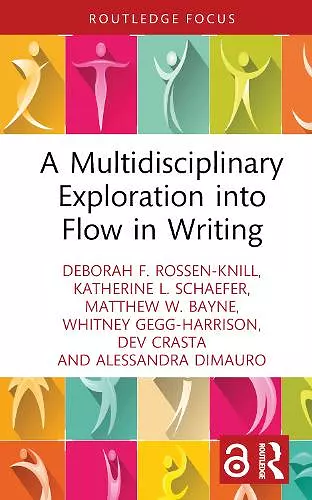A Multidisciplinary Exploration into Flow in Writing
Deborah F Rossen-Knill author Katherine L Schaefer author Matthew W Bayne author Whitney Gegg-Harrison author Dev Crasta author Alessandra DiMauro author
Format:Hardback
Publisher:Taylor & Francis Ltd
Published:5th Apr '24
Currently unavailable, and unfortunately no date known when it will be back

Offering a multidisciplinary exploration of “flow” and the often-nebulous ways it is conceptualized and operationalized in writing pedagogy, this book addresses a critical gap in writing studies.
Bringing together practice-based and scholarly perceptions, it outlines the key features and definitions of flow, and identifies pedagogical approaches and opportunities for classroom instruction. Incorporating perspectives from disciplines including classical rhetoric, composition studies, cognitive science, and linguistics, this book provides a diverse overview of the literature on flow in writing pedagogy. It includes two instructional voice-based and rhetorical grammar-based activities that outline how to recognize and improve flow in writing. In doing so, the book also provides clear examples of how to create an inclusive writing pedagogy that incorporates sensory and analytical perspectives to help readers and writers experience flow and meet their writing goals.
As an exploration of flow instruction as it currently stands and might stand in the future, this book will be of interest to students and instructors in the field of academic, professional and creative writing studies.
The Open Access version of this book, available at www.taylorfrancis.com, has been made available under a Creative Commons Attribution-Non Commercial-No Derivatives (CC-BY-NC-ND) 4.0 license.
“What is particularly impressive about the book is its multidisciplinary coverage, which includes not only linguistics but also classical rhetoric, composition studies, and cognitive science. Equally impressive is that the book covers not only student, instructor, and researcher perceptions about flow in writing but also empirical data to buttress its case. Unsubstantiated perceptions and feelings about improving student writing improvement are no match for empirical evidence, something which this book does not neglect. I believe the book offers very helpful guidance for writing theorists, writing instructors, and students seeking to master the craft of writing.”
Rei R. Noguchi, author of Grammar and the Teaching of Writing: Limits and Possibilities (1991).
“This book tackles that most nebulous and desired of writing qualities: flow. Refusing to let flow continue to be bandied about but little understood, the book offers an accessible investigation of flow from rhetorical, linguistic, and cognitive perspectives; then, it offers practical activities to help all of us better identify, understand, and incorporate flow in written English.”
Laura Aull, Associate Professor and Writing Program Director, University of Michigan, USA.
“This book offers a conceptually rich and empirically grounded answer to the thorny question, “What is flow in writing?” It provides a wealth of insights, strategies, and examples that can help teachers and students to recognize, improve, and even experiment with flow. The authors have me convinced that more focus on flow can reinvigorate the writing classroom and increase students’ sense of agency as communicators. I am excited to use this text to help deepen the understanding of students, faculty, writing center staff, and others about how and why flow actually ‘works’ in written texts!”
Shawna Shapiro, Associate Professor of Writing and Linguistics, Middlebury College, USA.
ISBN: 9781032604954
Dimensions: unknown
Weight: 453g
126 pages